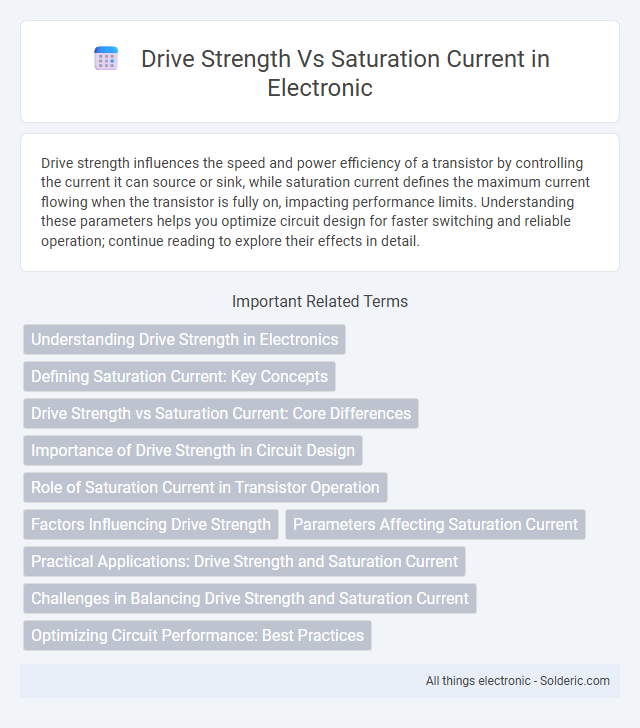Drive strength influences the speed and power efficiency of a transistor by controlling the current it can source or sink, while saturation current defines the maximum current flowing when the transistor is fully on, impacting performance limits. Understanding these parameters helps you optimize circuit design for faster switching and reliable operation; continue reading to explore their effects in detail.
Comparison Table
| Parameter | Drive Strength | Saturation Current |
|---|---|---|
| Definition | The maximum current a transistor gate can source or sink. | The maximum current flowing through a transistor in saturation mode. |
| Unit | Milliamps (mA) or Microamps (uA) | Milliamps (mA) or Amps (A) |
| Relevance | Determines switching speed and output drive capability. | Defines the maximum load current the transistor can maintain in saturation. |
| Impact on Circuit | Affects logic gate transition times and signal integrity. | Affects power dissipation and transistor conduction performance. |
| Measurement | Measured via gate current driving capability under load. | Measured by collector-emitter current when transistor is saturated. |
| Typical Usage | Used to size transistors for driving loads in digital circuits. | Used to ensure transistor operates safely without excessive power loss. |
Understanding Drive Strength in Electronics
Drive strength in electronics refers to a device's ability to source or sink current while maintaining signal integrity, directly impacting circuit speed and power consumption. Saturation current defines the maximum current a transistor can conduct when fully turned on, establishing a limit for the effective drive strength. Optimizing drive strength in digital circuits ensures faster switching times and reliable performance without exceeding saturation current thresholds that could cause device stress or failure.
Defining Saturation Current: Key Concepts
Saturation current refers to the maximum current a transistor can conduct when fully turned on, beyond which increases in drive strength no longer significantly increase the current flow. It represents the transistor's limit in delivering current to the load, critical in designing circuits for optimal switching performance. Understanding saturation current helps engineers balance drive strength and power efficiency to avoid transistor overheating and ensure reliable operation.
Drive Strength vs Saturation Current: Core Differences
Drive strength defines the maximum current a transistor can source or sink without significant voltage drop, directly influencing switching speed and signal integrity. Saturation current represents the maximum current flowing through a transistor when it is fully turned on, indicating the device's current carrying capability under saturation conditions. Understanding these core differences helps you optimize circuit performance by balancing drive strength for faster transitions and saturation current for reliable conduction.
Importance of Drive Strength in Circuit Design
Drive strength determines a transistor's ability to supply current to a load, directly impacting switching speed and signal integrity in circuit design. Saturation current represents the maximum current a device can conduct when fully on, but without sufficient drive strength, the transistor may not reach or maintain saturation, leading to slower transitions and increased power dissipation. Understanding the balance between drive strength and saturation current is crucial for optimizing your circuit's performance and ensuring reliable operation under varying load conditions.
Role of Saturation Current in Transistor Operation
Saturation current in transistors defines the maximum current that flows when the device is fully "on," directly influencing the drive strength or the transistor's ability to source or sink current. Your circuit's switching speed and power efficiency depend heavily on this saturation current, as it limits how quickly and efficiently the transistor can transition between on and off states. Optimizing the saturation current ensures reliable, high-performance transistor operation in various electronic applications.
Factors Influencing Drive Strength
Drive strength is primarily influenced by transistor size, gate oxide thickness, and supply voltage, which determine the maximum current the transistor can source or sink. Saturation current depends on carrier mobility, channel length, and doping concentration, impacting how much current flows when the transistor is fully on. Your circuit's speed and switching performance rely on balancing drive strength and saturation current to optimize device efficiency and reliability.
Parameters Affecting Saturation Current
Saturation current in transistors is primarily influenced by drive strength, which determines how effectively the transistor can switch to the saturation region. Key parameters affecting saturation current include the base or gate drive voltage, transistor geometry, carrier mobility, and temperature. Higher drive strength results in greater base or gate current, facilitating a higher saturation current and improved device performance in switching applications.
Practical Applications: Drive Strength and Saturation Current
Drive strength determines the maximum current a transistor can source or sink, directly affecting switching speed and power consumption in circuits like buffers and inverters. Saturation current defines the upper limit of current flow when a transistor is fully on, crucial for ensuring efficient operation without excessive power loss or thermal issues. Understanding the balance between drive strength and saturation current allows you to optimize transistor selection for reliable performance in high-speed digital and analog applications.
Challenges in Balancing Drive Strength and Saturation Current
Balancing drive strength and saturation current in transistor design presents challenges such as managing power consumption and heat dissipation while maintaining high switching speeds. High drive strength increases current flow, improving performance but risking saturation and device reliability issues. Your circuit's efficiency depends on optimizing this balance to prevent performance degradation and ensure stable operation.
Optimizing Circuit Performance: Best Practices
Optimizing circuit performance requires balancing drive strength and saturation current to ensure efficient transistor switching without excessive power consumption. Selecting a drive strength that matches the load capacitance minimizes delay while maintaining signal integrity, whereas controlling saturation current prevents device overheating and prolongs component lifespan. Employing precise transistor sizing and adaptive drive techniques enhances overall circuit reliability and speed.
Drive strength vs Saturation current Infographic

 solderic.com
solderic.com